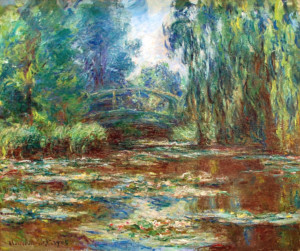After Vigils ends around 4:30 each morning, I make my way from the sacristy through the monastery courtyard toward the cloister. At that dark hour, it is an enchanted place, and the quality of the light changes with the phases of the moon and the cloud cover. Quiet rustlings betray the presence of cats and, sometimes, raccoons or possums. Most mornings, the birds are not yet awake. I enter the cloister, retire to my cell with a mug of black coffee (a caffeinated “sacrament” as a friend and fellow monk from Mexico once put it to me), and begin reading the Scriptures. All the while, I am aware of the slow dawning of the new day, as the morning star appears, the horizon begins to turn grey, and the birds begin their songs. An enterprising squirrel might scamper by on the mulberry tree outside my window.
God’s mysterious beauty is all around. We need not travel far to find it, even in an urban environment. It’s good to be reminded of this. Observing beauty is an urgent task in times of crisis, such as we have been experiencing here in Chicago. I propose this not as a distraction. Rather, as we respond to the pandemic and to violence, it is important to remind ourselves what our hopes are, and few things generate hope like an encounter with the beautiful. How we understand our situation depends on what we choose to occupy our attention. To the extent we delay our encounter with the beauty that God has built into His cosmos, we risk giving ourselves up to despair.
The contemplative life teaches us to notice beauty in places where others haven’t seen it yet. From our own attentiveness, we can learn to point beauty out to others. This is part of my hope in this series, that I can share with you some of the fruits of this attentiveness.
In the first set of reflections, I will enlist the skills of a great listener, Claude Debussy (1862-1918) to assist us. In 1909, he began composing a set of twelve piano preludes. They are masterful evocations, often of everyday settings. Each has a descriptive title, drawing our attention to the wind, evenings scents, footsteps in the snow, cathedral bells, and amateur musicians, busking in the park, serenading at windows.
Until recently, I had been reluctant to admit Debussy’s profound influence on my own musical sensibilities. His style can strike the new listener as intoxicating, perhaps hedonistic. Quotes from the composer himself seem to reinforce this initial impression:
“Some people wish above all to conform to the rules, I wish only to render what I can hear. There is no theory. You have only to listen. Pleasure is the law.”
It’s almost as if Debussy was intending to alienate someone like me, who is suspicious of decadence and who, as an aspiring composer, once spent hours learning theory. Yet, his music has attracted me again and again. And it’s grown profounder as I’ve learned to listen more closely.

“Water Lily Pond and Bridge” by Claude Monet, 1905. Monet’s visual techniques are often compared with Debussy’s musical effects.
Here is a more sympathetic reading of the above quote. When Debussy says that his goal is to “render what [he] can hear,” we should bear in mind that the man speaking is widely regarded as a musical genius, someone who is likely able to hear things that the rest of us cannot. His wish to render what he hears is akin to what a painter does for us visually. A great painting can make the familiar seem new and strange. Monet, a painter whose art is similar to Debussy’s in many ways, could make a haystack seem beautiful by his ability to capture the light around it in varying ways. In a similar way, Debussy will call our attention to nuances in our surroundings. His musician’s ear catches aspects of life that most of us would miss. He invites the listener to reflect on the beauty present in everyday experience.
The older I’ve gotten, the more sympathetic I am to Debussy’s critique of rules. I’ve learned through experience the importance of rules and also their insufficiency for many tasks in life. Wisdom discerns those moments when the rules can be dismissed.
As a young composer, Debussy demonstrated that he could work within the conventions of the time, but he was also willing to dispense with rules of musical theory in order to capture the unpredictable reality of life observed. He also was no dilettante. The Preludes especially are the work of a perfectionist. There are no notes out of place.
The variety and unfamiliarity of Debussy’s individual pieces are responses to the variety and unfamiliarity of life’s experiences. In the Preludes, we hear this strangeness refracted through Debussy’s highly refined ability to hear and notate what he hears. In other words, Debussy had cultivated a kind of contemplative approach to music-making. He is giving us the opportunity of seeing and hearing the world around us with greater precision and insight.
Before diving into the Preludes, let me leave you with a much earlier and more famous piece, his youthful masterwork, Clair de Lune (moonlight). As you listen, see how the music uses different dynamics (volume levels), registers, and textures to suggest different facets of the moon’s appearance, and the dreamlike traits of moonlight. How do the different textures of music depict the moon’s movement through the night sky? When was the last time we carefully observed the moon, or familiar objects made mysterious by its diffuse illumination? Is Debussy also drawing our attention to clouds or wind or other celestial objects? What does the experience of moonlight say about God?